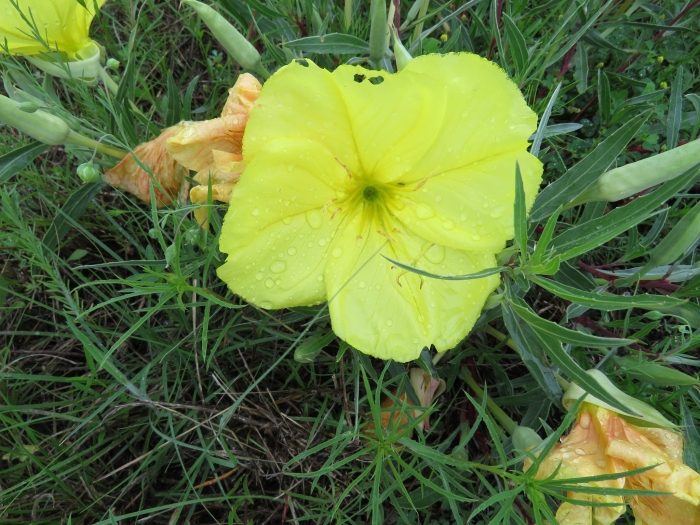Bigfruit Evening Primrose
(Oenothera macrocarpa)
Bigfruit Evening Primrose (Oenothera macrocarpa)
/
/

henrya
Public Domain
Image By:
henrya
Recorded By:
Copyright:
Public Domain
Copyright Notice:
Photo by: henrya | License Type: Public Domain | License URL: http://creativecommons.org/publicdomain/zero/1.0/ | Rights Holder: henrya | Publisher: iNaturalist | Date Created: 2021-04-30T10:53:08-07:00 |

















































Estimated Native Range
Summary
Oenothera macrocarpa, commonly known as Bigfruit Evening Primrose, is a semi-deciduous perennial herb that is native to glades, rocky prairies, and open woodlands in the Central United States. It typically grows to a height of 0.8-1 feet (0.2-0.3 meters) and a width of 1-2 feet (0.3-0.6 meters). The plant has a sprawling habit with large, cup-shaped, bright yellow flowers that bloom profusely from late spring to early summer, adding a splash of color to the garden. The flowers are particularly showy at dusk when they open, hence the name "evening primrose." Its foliage is a bluish-green, and the plant produces conspicuous, winged seed pods after flowering.
Bigfruit Evening Primrose is valued for its drought tolerance and ability to thrive in poor, rocky soils, making it an excellent choice for xeriscaping and rock gardens. It is also used in native plant gardens and as a ground cover. This species prefers full sun and well-drained soils, and once established, it requires minimal maintenance. It is resistant to deer and attracts pollinators such as bees and moths. While it is not typically prone to serious pests or diseases, overwatering or poorly drained soils can lead to root rot. It has been awarded the Royal Horticultural Society’s Award of Garden Merit for its outstanding qualities as a garden plant.CC BY-SA 4.0
Bigfruit Evening Primrose is valued for its drought tolerance and ability to thrive in poor, rocky soils, making it an excellent choice for xeriscaping and rock gardens. It is also used in native plant gardens and as a ground cover. This species prefers full sun and well-drained soils, and once established, it requires minimal maintenance. It is resistant to deer and attracts pollinators such as bees and moths. While it is not typically prone to serious pests or diseases, overwatering or poorly drained soils can lead to root rot. It has been awarded the Royal Horticultural Society’s Award of Garden Merit for its outstanding qualities as a garden plant.CC BY-SA 4.0
Plant Description
- Plant Type: Herb
- Height: 0.8-1 feet
- Width: 1-1.5 feet
- Growth Rate: Moderate
- Flower Color: Yellow
- Flowering Season: Spring, Summer
- Leaf Retention: Semi-Deciduous
Growth Requirements
- Sun: Full Sun
- Water: Low, Medium
- Drainage: Fast
Common Uses
Bank Stabilization, Bee Garden, Bird Garden, Border Plant, Butterfly Garden, Deer Resistant, Drought Tolerant, Fragrant, Groundcover, Hummingbird Garden, Low Maintenance, Potted Plant, Rabbit Resistant, Rock Garden, Showy Flowers, Street Planting
Natural Habitat
Native to glades, rocky prairies, and open woodlands in the Central United States
Other Names
Common Names: Ozark Sundrop, Missouri Evening Primrose, Bigfruit Eveningprimrose, Missouri-Nachtkerze, Storblommigt Nattljus
Scientific Names: , Oenothera macrocarpa, Oenothera missouriensis f. elongata, Oenothera missouriensis var. latifolia, Oenothera macarocarpa,
GBIF Accepted Name: Oenothera macrocarpa Nutt.